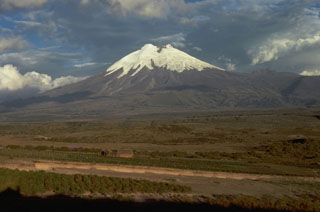Report on Cotopaxi (Ecuador) — 22 March-28 March 2023
Smithsonian Institution / US Geological Survey
Weekly Volcanic Activity Report, 22 March-28 March 2023
Managing Editor: Sally Sennert.
Please cite this report as:
Global Volcanism Program, 2023. Report on Cotopaxi (Ecuador) (Sennert, S, ed.). Weekly Volcanic Activity Report, 22 March-28 March 2023. Smithsonian Institution and US Geological Survey.
Cotopaxi
Ecuador
0.677°S, 78.436°W; summit elev. 5911 m
All times are local (unless otherwise noted)
IG reported that eruptive activity at Cotopaxi was ongoing during 22-28 March. Gas-and-steam emissions were visible during 21-24 March rising as high as 1 km above the crater rim and drifting E; weather clouds prevented views of the volcano on 23 March. Ash emissions rose 500-800 m above the crater rim and drifted SW and SE during 25-26 March. Ash plumes rose 1.1 km above the crater rim and rifted SE, NE, and NW on 27 March. Ash plumes rose as high as 2 km above the crater rim on 28 March and drifted NW, causing minor ashfall in the Machachi parish on the N flank, in Parque Nacional Cotopaxi. Servicio Nacional de Gestión de Riesgos y Emergencias (SNGRE) maintained the Alert Level at Yellow (the second lowest level on a four-color scale).
Geological Summary. The symmetrical, glacier-covered, Cotopaxi stratovolcano is Ecuador's most well-known volcano and one of its most active. The steep-sided cone is capped by nested summit craters, the largest of which is about 550 x 800 m in diameter. Deep valleys scoured by lahars radiate from the summit of the andesitic volcano, and large andesitic lava flows extend to its base. The modern edifice has been constructed since a major collapse sometime prior to about 5,000 years ago. Pyroclastic flows (often confused in historical accounts with lava flows) have accompanied many explosive eruptions, and lahars have frequently devastated adjacent valleys. Strong eruptions took place in 1744, 1768, and 1877. Pyroclastic flows descended all sides of the volcano in 1877, and lahars traveled more than 100 km into the Pacific Ocean and western Amazon basin. Smaller eruptions have been frequent since that time.
Sources: Instituto Geofísico-Escuela Politécnica Nacional (IG-EPN), Servicio Nacional de Gestión de Riesgos y Emergencias (SNGRE), Washington Volcanic Ash Advisory Center (VAAC)

